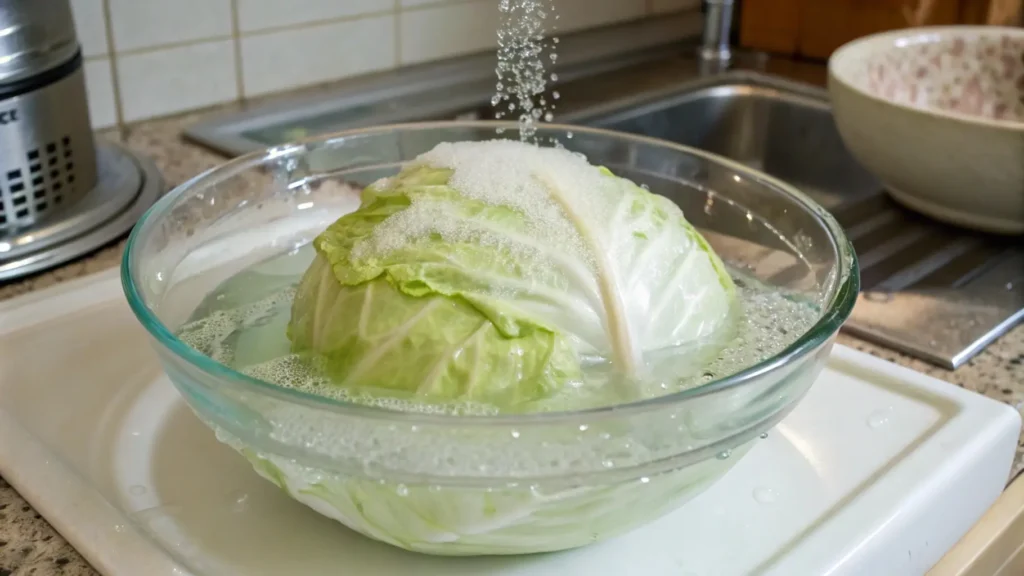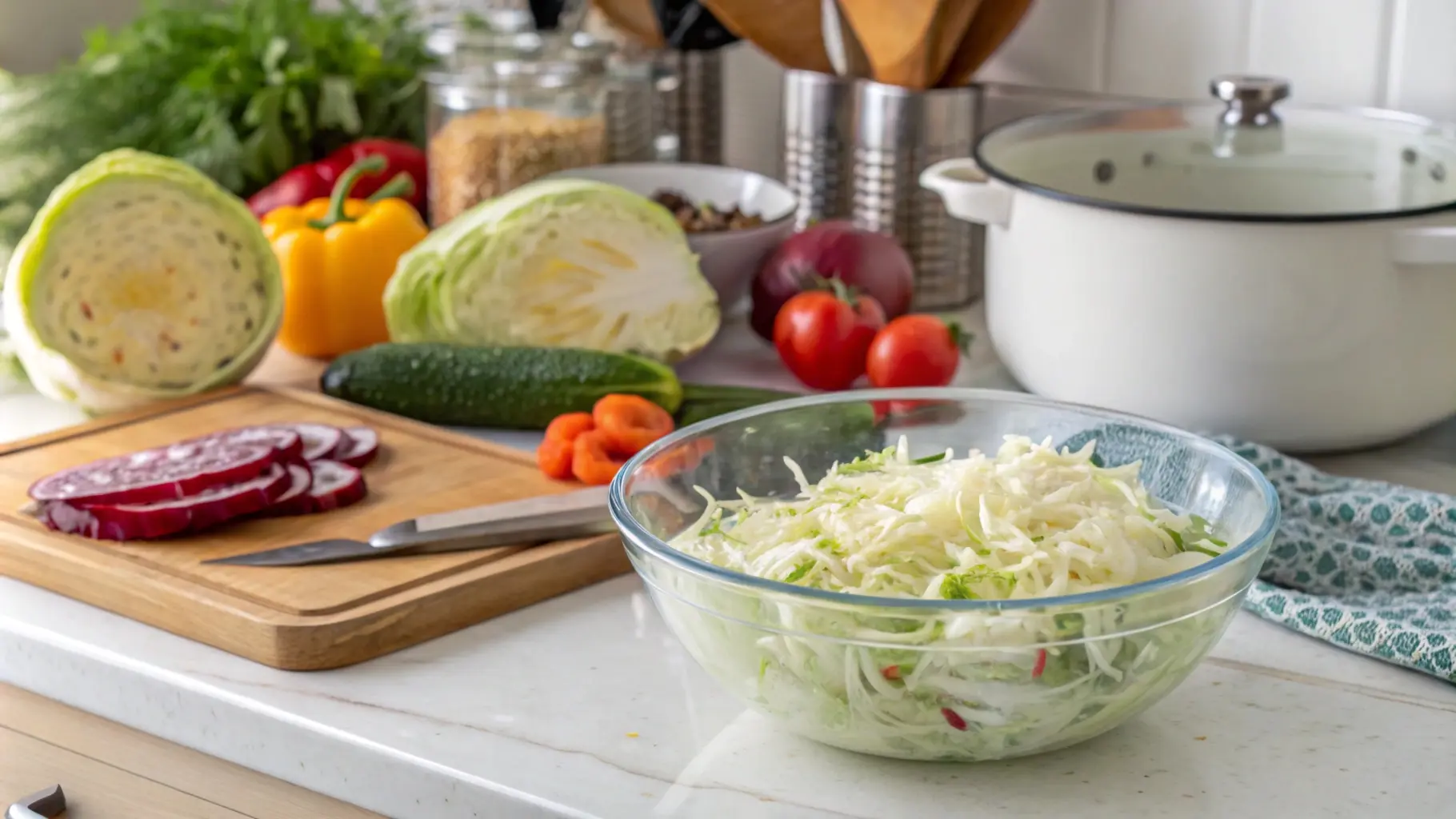When it comes to preparing cabbage, soaking is a step that often sparks curiosity. Why do people go to the trouble of soaking this humble vegetable before cooking it? From enhancing its natural crispness to removing any lingering dirt or bitterness, soaking plays a pivotal role in unlocking cabbage’s culinary potential. This article delves into the why and how of soaking cabbage, exploring the benefits, techniques, and frequently asked questions that every home cook should know. Let’s start by examining the foundation of this practice.
Introduction to Soaking Cabbage
Why Is Soaking Cabbage a Common Practice?
Cabbage is a versatile vegetable, making its way into dishes like coleslaw, stir-fries, and hearty soups. But to get the most out of it, some preparation is required. Soaking cabbage is a time-honored tradition rooted in the need to clean it thoroughly and improve its texture. This step ensures your cabbage is free of hidden dirt, insects, and those pesky bits that can mar its natural goodness.
The process is not just about cleanliness, though. Soaking helps balance the vegetable’s natural flavors, taming its pungent edge and reducing bitterness. It’s a quick and effective way to prepare cabbage for raw or cooked dishes.
Overview of Cabbage’s Characteristics and Uses
Cabbage belongs to the family of cruciferous vegetables, which are known for their health benefits and hearty flavor. Packed with nutrients like Vitamin C, fiber, and antioxidants, it’s a powerhouse ingredient that fits into a range of diets. Whether shredded for coleslaw, stuffed for rolls, or pickled into sauerkraut, cabbage’s versatility shines when it’s handled with care. Soaking cabbage is a small yet significant step that ensures it performs beautifully in your favorite recipes.
Benefits of Soaking Cabbage
Enhancing Crispiness and Freshness
One of the most compelling answers to why do you soak cabbage before cooking is its ability to enhance the natural crispiness of the leaves. If you’ve ever experienced limp slaw or a soggy salad, you know how important texture can be. Soaking cabbage in cold water hydrates its leaves, helping them bounce back and regain their crunch. This is especially useful for shredded cabbage, which tends to lose moisture quickly when exposed to air.
Cold water not only improves texture but also helps preserve the vibrant green or purple hues of the vegetable, making your dishes visually appealing. So, why do you soak cabbage before cooking for raw salads? A quick soak ensures each bite is as crisp and satisfying as possible.
Reducing Bitterness and Strong Odors
Cabbage’s natural flavor can sometimes lean toward the bitter side, particularly when it’s raw. If you’ve wondered why do you soak cabbage before cooking, the answer lies in how soaking balances the flavor. Water, especially when combined with a pinch of salt or vinegar, gently leaches out bitter compounds, making the vegetable more palatable. This step is essential for dishes like salads or stir-fries, where flavor harmony is key.
Another great reason to soak is to minimize the strong sulfuric smell that cabbage releases during cooking. By soaking beforehand, you’ll reduce this odor significantly, resulting in a more enjoyable cooking and dining experience.
Eliminating Pests and Dirt
Cabbage leaves are densely packed, creating spaces where dirt, sand, or tiny pests might hide. If you’ve ever handled organic cabbage, you know it often comes with a few “natural” surprises. Why do you soak cabbage before cooking when it comes to cleanliness? A thorough soak dislodges unwanted debris and ensures the vegetable is safe to eat.
For tougher cleaning tasks, using saltwater or vinegar water is highly effective. This not only eliminates visible dirt but also sanitizes the cabbage, giving you complete peace of mind as you prepare it.
Preserving Vibrant Colors During Cooking
When cooking cabbage, its bright, natural colors can fade. Soaking beforehand helps preserve these hues, ensuring your dishes look as good as they taste. Red cabbage, for instance, benefits greatly from a vinegar soak, which locks in its rich purple color. Green cabbage also stays vibrant when soaked in cold water before steaming or boiling.
So, why do you soak cabbage before cooking when color matters? The process prevents dullness, keeping your dishes visually stunning while retaining their full flavor. For more cooking tips, visit Epicurious.
Different Methods of Soaking Cabbage

Soaking in Cold Water: Crisp and Fresh Results
The simplest and most common way to soak cabbage is in cold water. This method is ideal for raw preparations like salads or slaws, as it helps the vegetable retain its crunchy texture. Just chop or shred the cabbage, place it in a large bowl of cold water, and let it sit for about 10-15 minutes. For even better results, toss a few ice cubes into the mix.
Once soaked, drain the cabbage well using a colander. Pat it dry with a clean kitchen towel to ensure no excess water dilutes your dish.
Using Saltwater to Improve Flavor and Texture
For recipes requiring a flavor boost, soaking cabbage in saltwater is a fantastic option. Salt draws out excess moisture from the leaves, which not only intensifies the flavor but also tenderizes the texture. To do this, dissolve about a tablespoon of salt in a bowl of water, submerge the cabbage, and let it soak for 15-20 minutes.
This method is perfect for cabbage rolls, stir-fries, or pickling. Don’t forget to rinse the cabbage thoroughly after soaking to remove any lingering saltiness.
Vinegar Water for Cleaning and Removing Residues
If you’re dealing with particularly dirty or pesticide-laden cabbage, soaking it in a mixture of water and vinegar is highly effective. Add a tablespoon of vinegar to a bowl of water and let the cabbage sit for 10-15 minutes. This helps remove any stubborn dirt, waxy residues, or even bacteria.
Vinegar soaks are especially useful for red cabbage, as they help preserve its striking color. After soaking, rinse the leaves under running water to ensure they’re clean and ready to cook.
Which Method Is Right for Your Recipe?
Each soaking method serves a specific purpose, so choosing the right one depends on your recipe. For raw dishes, stick with cold water. For cooked or fermented preparations, saltwater or vinegar water can be more effective. Regardless of the method, soaking cabbage enhances its quality, making it a step worth adding to your cooking routine.
So, why do you soak cabbage before cooking? It’s all about achieving better flavor, texture, and presentation—small steps that make a big difference in your final dish!
Soaking for Specific Cooking Techniques
Prepping Cabbage for Raw Dishes Like Salads and Coleslaw
For raw dishes, soaking cabbage in cold water ensures a fresh and crunchy texture, which is key for recipes like coleslaw or shredded salads. Cold water restores moisture to the leaves and keeps them crisp, even when mixed with creamy or acidic dressings. If you’re wondering why do you soak cabbage before cooking or preparing it raw, this step makes all the difference in creating a satisfying bite.
Once soaked, pat the cabbage dry thoroughly before mixing it into your recipe. Excess water can dilute your dressing, leading to soggy results.
Pre-Soaking for Steaming, Boiling, and Stir-Frying
When cabbage is cooked, its natural bitterness can become more pronounced. Soaking the leaves in saltwater or vinegar water before steaming or stir-frying helps reduce this bitter taste. For boiling, soaking also minimizes the release of sulfur compounds, which can cause an unpleasant smell during cooking. This preparation method is particularly effective for dishes like cabbage soup or stir-fried vegetables, where flavor and aroma are critical.
By soaking first, you can improve both the texture and flavor of your cooked cabbage, ensuring it blends seamlessly with other ingredients.
Special Considerations for Pickling and Fermenting
Pickling and fermenting cabbage, such as in sauerkraut or kimchi, require extra care in preparation. Soaking cabbage in saltwater softens the leaves slightly and makes them more pliable for packing into jars. This method also jump-starts the fermentation process by drawing out excess water, which is crucial for proper preservation. Whether you’re making spicy kimchi or tangy sauerkraut, a quick soak enhances the quality of your final product.
Common Questions About Soaking Cabbage
How Long Should Cabbage Be Soaked?
The length of time needed to soak cabbage depends on the method. For cold water soaks, 10-15 minutes is sufficient to revive its crunch and remove dirt. Saltwater or vinegar soaks may take a little longer—about 15-20 minutes—to properly clean and tenderize the leaves. If you’re preparing cabbage for fermentation, a longer soak may be needed to fully draw out moisture.
Should Cabbage Be Rinsed After Soaking?
Absolutely! After soaking, it’s essential to rinse the cabbage thoroughly to remove any lingering salt, vinegar, or dirt. Use cold running water to ensure every leaf is clean. Rinsing also prevents unwanted flavors from impacting your dish, leaving you with perfectly prepped cabbage.
Can Soaking Cabbage Prevent Gas and Bloating?
Soaking cabbage may help reduce the gas and bloating often associated with cruciferous vegetables. Adding garlic or bay leaves to the soaking water can further reduce compounds that cause gas during digestion. This simple preparation step makes cabbage dishes more enjoyable for those with sensitive stomachs.
What Happens If You Skip Soaking?
Skipping the soaking step can lead to unpleasant surprises, like finding grit, pests, or bitter flavors in your dish. Soaking is a small investment of time that yields significant improvements in taste, texture, and cleanliness.
Additional Tips for Preparing Cabbage
Avoid Overcooking for Optimal Taste
Overcooking cabbage can turn a delicious dish into a soggy, unpleasant mess. The sulfur compounds in cabbage intensify with prolonged heat, creating a strong, off-putting smell. To avoid this, cook it just until tender. Whether you’re steaming, boiling, or stir-frying, aim for a balance that preserves its crunch while softening the tougher parts.
For dishes like stir-fried cabbage or cabbage rolls, monitor the cooking process closely to keep the flavors fresh and appealing.
Storing Cabbage for Extended Freshness
Proper storage is essential for maintaining cabbage’s quality. Keep it in the crisper drawer of your fridge, tightly wrapped in plastic, and it should last up to two weeks. Once cut, use the remaining cabbage within two or three days to ensure it stays crisp and tasty.
If you’re planning ahead, why do you soak cabbage before cooking? It helps refresh the leaves and brings out their best texture before cooking or serving.
Pairing Cabbage with Complementary Flavors
Cabbage’s mild yet earthy flavor pairs beautifully with a variety of ingredients. It goes well with bold spices like garlic, ginger, and pepper, or hearty meats like pork and beef. Adding a splash of vinegar or lemon juice can brighten its taste, making it a versatile base for soups, stews, and side dishes.
FAQs on Soaking and Cooking Cabbage
What Is the Best Way to Clean Cabbage?
The best method depends on your needs. For a quick rinse, cold water works well to remove dirt and debris. If deeper cleaning is required, soaking cabbage in saltwater or vinegar water is highly effective for dislodging grit and eliminating potential pests. This step ensures the vegetable is clean and ready for cooking.
Does Soaking Cabbage Change Its Nutritional Value?
Not significantly! Soaking cabbage doesn’t strip away its nutrients. In fact, this preparation step can help preserve vitamins by reducing the need for extended cooking times. Packed with Vitamin C, fiber, and antioxidants, cabbage retains its health benefits whether soaked or not.
Can Soaking Cabbage Help With Digestive Issues?
Yes, soaking cabbage can make it easier to digest. Saltwater soaks, in particular, reduce compounds that cause bloating or gas, making cabbage more stomach-friendly. If you’re prone to digestive discomfort, soaking is a simple way to enjoy this nutrient-rich vegetable without worry.
Is There a Specific Type of Cabbage That Requires Soaking?
All types of cabbage—green, red, savoy, or napa—benefit from soaking. Each variety has unique textures and flavors, but the process of soaking helps enhance their natural qualities while improving cleanliness.
Conclusion: Making the Most of Your Cabbage
Summarizing the Benefits and Techniques
Soaking cabbage is a simple yet essential step that elevates both its flavor and texture. From refreshing its crispness for salads to reducing bitterness for cooked dishes, this preparation method ensures cabbage performs at its best. If you’ve ever wondered, why do you soak cabbage before cooking, the answer lies in improving its overall quality and versatility.
Encouraging Experimentation with Soaking Methods
Don’t hesitate to experiment with different soaking techniques—cold water for freshness, saltwater for flavor, or vinegar water for cleanliness. Each method brings unique benefits to your favorite recipes, making soaking a worthy addition to your cooking routine.

